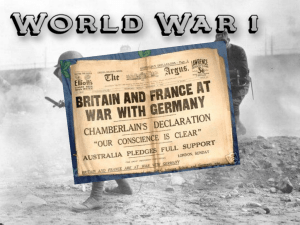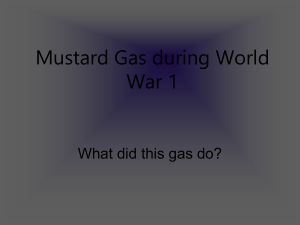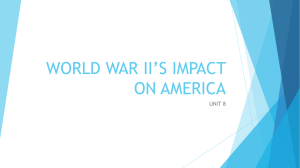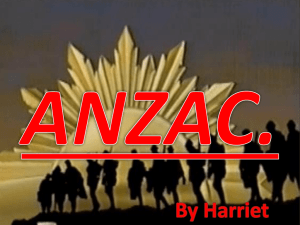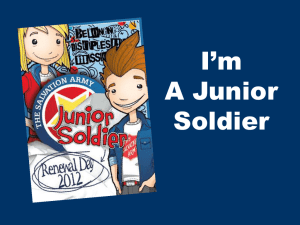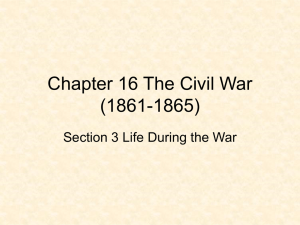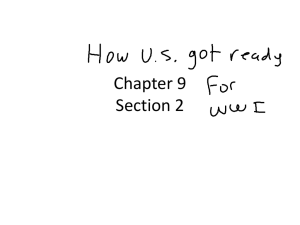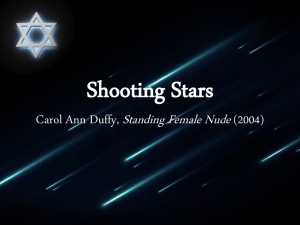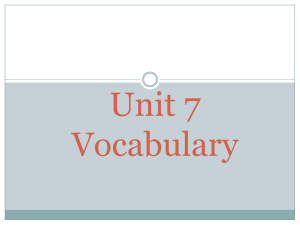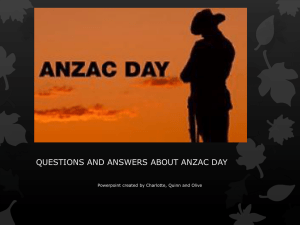Keating
advertisement
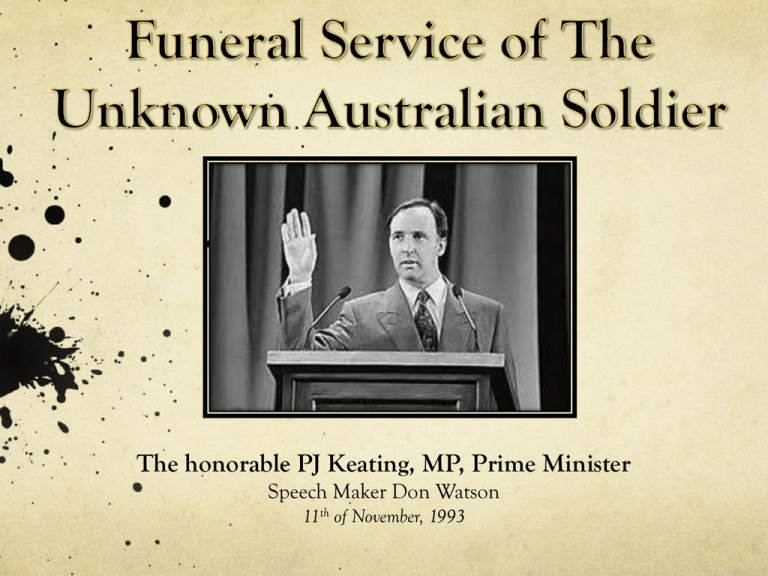
The honorable PJ Keating, MP, Prime Minister Speech Maker Don Watson 11th of November, 1993 Context for Speech • Keating two years into PM role • Held on 11th November, the day Australian’s celebrate Armistice Day and the end of WWI/Remembrance Day • May b1993- Republic Advisory Committee set up- created by the Keating Labor government, the Committee laid the foundations for proposed Constitutional change • Mabo- 1992/ Native title- 1993- Both movements involving Aboriginal identity and their struggle towards national reconciliation, this factor led Keating to word his speech in a way that was still emotionally impacting, yet respectful of the Aboriginal community. • Speech was delivered in the middle of the Reconciliation debate- concerns about Aboriginal and Non-Aboriginal identity. Keating had to be careful with wording as to not offend any particular party. • Worked with speech writer Don Watson who believed that once a speech is delivered, it is the property of the speechmaker, as it gives their views, attitudes, preferred language and intonation. Central Idea/argument • • • • • • • • • • • Democracy, nationalism and unity of spirit Mateship, courage, duty and loyalty Non-glorification of war The paradox of one representing many War is meaningless, but a soldiers life is meaningful The recognition of the sacrifice of one, symbolises the sacrifices of all soldiers We should acknowledge and be grateful of their sacrifices Unknown soldier encapsulated as ‘the true heart of the nation’ Generate pride Promotes Australian values Calls all Australians to celebrate the work of soldiers Values Explored Non-glorification of war • “because the Great war was mad, brutal, awful, awful struggle, distinguished more often then not by military and political incompetence…victory was scarcely discernible from defeat…” Keating sums up this war as ‘inexcusable folly” • The war is portrayed as a tragedy, where victory was also defeat • They are not glorifying war, but honoring the sacrificed lives of all the soldiers, from all countries and sides of war • “for out of the war came a lesson which transcended the horror and tragedy and the inexcusable folly it was a lesson to ordinary people….that they were not ordinary” • The war allowed for the ordinary people of society to achieve the extraordinary. The hero’s, Soldiers, sailors, nurses all taught a nation to endure hardship, to show courage, to be bold and resilient, believe in themselves and to unite the nation as a group Values Explored One representing many • “he is all of them, and one of us” • “it was a lesson about ordinary people – and the lesson was they were not ordinary” • The unknown soldier honours the memory of all the men and women who laid down their lives for Australia • By honouring the memory of the many through just one person, it is a reminder of the loss caused by war and the lessons people and war which was gained (honouring and remembering the dead and their sacrifices, hardships and impact on the nation) • One gain is a legend of bravery and sacrifice, a deeper faith in the nation and a ‘deeper understanding of what it means to be Australian’ • However, the unknown soldier not only honours the past, but also ‘enshrines a nations love of peace’ Values Explored Democracy, nationalism, unity • His family is lost to us as he was lost to them” • Democracy (majority decision making, by the people for the people) • Makes reference to the ANZAC story Australian legend of bravery, sacrifice lead to a deeper faith in the nation as a whole and its democracy as well as a deeper understanding of what it means to be Australian • “ a legend of free and independent whose disciplines derived less from military formalities and customs than from the bonds of mateship and demands of necessity” • The story of the unknown soldier is the heart of the ANZAC legend, which leads to a deeper of what it means to be Australian, the values of unity and nationalism, which are a tradition which Australians “have gone to war with ever since Values Explored Mateship, courage, duty, loyalty • Soldiers sacrifice for their nation, as well as for each other • Links to the ANZAC story, the sacrifices soldiers make for each other, as well as all of us • “on all sides they were the heroes of that war…the soldiers, sailors and nurses, those who taught us to endure hardship, to show courage, to be bold as well as resilient, to believe in ourselves, to stick together” • “He went for no other reason than that he believed it was the duty he owed his country and his king” • By honouring the unknown soldier, the nation is also honouring their values on the treatment of others, each other and their reason to fight • Honouring mateship which entails unity as a nation in the battlefield, courage to accept their duty to their nation, to defend it, loyalty for Australia and their ‘mates’ Structure of Speech Introduction • Begins with a short and abrupt statement which sets the tone for the speech, and establishes the persona of the unknown soldier, and how he represents all those fighting for their country "We do not know this Australians name and we never will" • Introduces recurring use of inclusive language to follow opening sentence • This paragraph leads into details on the characteristics of different soldiers and the sacrifices they make to serve their country Structure of Speech Body • introduces statistics into the fatalities and number of people who represent their country and outlines the history of Australia's spirit, referenced with the mention of the ANZAC soldiers We know that he was one of the 45,000 Australians who died on the western front. One of the 416000 Australian's who volunteered for service in the first World War..." • Use of truncated sentences and rhetorical questions break up points and coalesce two points together to keep the flow of the speech going E.g. "He is one of them. And he is one of us." • Communicates the main purpose of the speech, that is, highlighting the courage and bravery of the Australian soldiers, both fallen and those still defending their country, and reiterates the values they live by in the ANZAC spirit "On all sides they were the heroes of that war; not the generals and the politicians but the soldiers and sailors and nurses- those who taught us to endure the hardship, to show courage, to be bold as well as resilient, to believe in ourselves and stick together" • Goes into details into specific scenarios soldiers found themselves in and this contributed to the challenges they faced to fight for their country "We do not know his age or his circumstances- whether he was from the city or from the bush; what occupation he left to become a soldier; what religion; if he had a religion; is he was married or single." Structure of Speech Conclusion • Concludes to never forget the soldiers they are gathered to remember, and to promote a sense of hope that lives in all those present as long Australian soldiers continue to serve • Begins to wrap up the speech with "We have lost more than 100,000 lives, and with them all their love of this country... We have gained a legend: a story of bravery" showing a paradox between the mourning of the fallen soldiers paralleled with the legend they leave behind and the hope it promotes • Concludes with extensive use of inclusive language, that "there is faith enough for all of us" reiterating that the audience is also linked to the unknown soldier being discussed throughout the entirety of the speech, and the extent that the consequences have on those who remain behind Rhetorical devices and examples • Truncated sentences “He is all of them. And one of us” Emphasises the way that the fallen soldiers as one of us, and their sacrifice was for us • Inclusive language “His family is lost to us and he was lost to them” Used to create a sense of unity within the audience and see the loss of a soldier as one similar to the loss of a family member • Asyndeton “ The tide of events since he died has been so dramatic, so vast and all consuming” Creates a direct dramatic effect, also acts as almost an after thought of Keating • Anaphora “We do not know his rank or his battalion. We do not..” Emphasises the fact that we do not know anything about this soldier, it also creates a dramatic effect as Keating’s tone would have most likely changed throughout successive phrases Links to other speeches Faith Bandler – Faith, Hope and Reconciliation – 1999 This links to the speech due to its exploration, and purpose, of unity within community . This speech also links to Bandler’s speech as it makes an attempt at not offending/antagonising the audience’s views on the war, especially when Keating is commenting on the war being a horrendous. The world ‘Gallipoli’ has not appeared within the speech, which is odd considering the subject of the speech relates to war. This has most likely been done by Keating in order to portray his opinion that that war was a catastrophe. However, the purpose of the speech is to honour the sacrifices of the dead for their nation, not the glorification of war. This is similar to how Bandler relies on personal experiences and stories of injustice to achieve social justice by listening, rather than antagonising and offending the audience. She may challenge their views, however portrays her own views to overcome cultural prejudices. Critical Commentary • When the speech was first presented to an audience, off the back of the war tragedy, it had a massive impact, it addressed many very sensitive issues and had high levels of emotive language which contributed to its impact • The values addressed in this speech will transcend time, although the emotion behind the unknown soldier has faded over time, the values of mateship, courage, duty, loyalty etc. will remain relevant to the lives of all Australians
